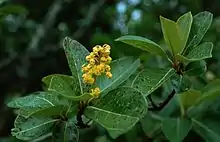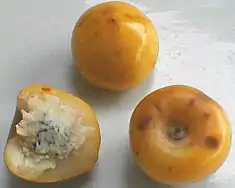Byrsonima crassifolia
Byrsonima crassifolia is a species of flowering plant bearing fruit in the acerola family, Malpighiaceae, that is native to tropical America. Common names include changunga, muruci, murici, nanche, nance, nancite, chacunga, craboo, kraabu, savanna serrette (or savanna serret) and golden spoon. In Jamaica it is called hogberry (plural hogberries).
| Byrsonima crassifolia | |
|---|---|
 | |
| Byrsonima crassifolia | |
| Scientific classification | |
| Kingdom: | Plantae |
| Clade: | Tracheophytes |
| Clade: | Angiosperms |
| Clade: | Eudicots |
| Clade: | Rosids |
| Order: | Malpighiales |
| Family: | Malpighiaceae |
| Genus: | Byrsonima |
| Species: | B. crassifolia |
| Binomial name | |
| Byrsonima crassifolia | |
| Synonyms[2] | |
|
Malpighia crassifolia L. | |
 | |
| Nutritional value per 100 g (3.5 oz) | |
|---|---|
| Energy | 306 kJ (73 kcal) |
16.97 g | |
| Sugars | 8.31 g |
| Dietary fiber | 7.5 g |
1.16 g | |
0.66 g | |
| Vitamins | Quantity %DV† |
| Vitamin A equiv. | 1% 5 μg569 μg |
| Thiamine (B1) | 1% 0.015 mg |
| Riboflavin (B2) | 2% 0.018 mg |
| Niacin (B3) | 2% 0.29 mg |
| Pantothenic acid (B5) | 4% 0.18 mg |
| Vitamin B6 | 2% 0.021 mg |
| Folate (B9) | 2% 8 μg |
| Vitamin C | 111% 92.5 mg |
| Vitamin E | 8% 1.25 mg |
| Vitamin K | 11% 11.9 μg |
| Minerals | Quantity %DV† |
| Calcium | 5% 46 mg |
| Iron | 3% 0.38 mg |
| Magnesium | 6% 20 mg |
| Manganese | 12% 0.248 mg |
| Phosphorus | 1% 10 mg |
| Potassium | 5% 244 mg |
| Sodium | 0% 3 mg |
| Zinc | 1% 0.09 mg |
| |
| †Percentages are roughly approximated using US recommendations for adults. Source: USDA FoodData Central | |
It's valued for its small (between one, and one and a quarter centimeter in diameter) round, sweet yellow fruit which is strongly scented. The fruits have a very pungent and distinct flavor and smell. The taste has been described as combination of pear, lychee and banana. When jarred, the texture resembles that of a green or kalamata olive.
Description and habitat
Byrsonima crassifolia is a slow-growing large shrub or tree to 33 ft (10 m). Sometimes cultivated for its edible fruits, the tree is native and abundant in the wild, sometimes in extensive stands, in open pine forests and grassy savannas, from central Mexico, through Central America, to Colombia, Peru, Bolivia and Brazil; it also occurs in Trinidad, Barbados, Curaçao, St. Martin, Dominica, Guadeloupe, Puerto Rico, Haiti, the Dominican Republic and throughout Cuba and the Isle of Pines. The nance is limited to tropical and subtropical climates. In Central and South America, the tree ranges from sea-level to an altitude of 6,000 ft (1,800 m). It is highly drought-tolerant.
.jpg.webp) Fruit
Fruit.jpg.webp) Flowers
Flowers Leaves
Leaves.jpg.webp) Tree
Tree
Example ecoregions of occurrence
Found in a number of tropical and subtropical ecoregions of the Americas that feature conifers, an example ecoregion of occurrence for B. crassifolia is the Belizean pine forests.[3]
Uses

The fruits are eaten raw or cooked as dessert. In rural Panama, the dessert prepared with the addition of sugar and flour, known as pesada de nance, is quite popular. The fruits are also made into dulce de nance, a candy prepared with the fruit cooked in sugar and water. In Nicaragua (where the fruit is called nancite), it is a popular ingredient for several desserts, including raspados (a frozen dessert made from a drink prepared with nancites) and a dessert made by leaving the fruit to ferment with some sugar in a bottle for several months (usually from harvest around August–September until December) -- this is sometimes called "nancite in vinegar".
The fruits are also often used to prepare carbonated beverages, ice cream and juice, in Brazil, flavor mezcal-based liqueurs, or make an oily, acidic, fermented beverage known as chicha, the standard term applied to assorted beer-like drinks made of fruits or maize. Nance is used to distill a rum-like liquor called crema de nance in Costa Rica. Mexico produces a licor de nanche.
References
- "Byrsonima crassifolia (L.) Kunth". TROPICOS. Missouri Botanical Garden. Retrieved 2010-03-30.
- "Byrsonima crassifolia". Germplasm Resources Information Network (GRIN). Agricultural Research Service (ARS), United States Department of Agriculture (USDA). Retrieved 2010-03-30.
- C. Michael Hogan & World Wildlife Fund. 2012. Belizean pine forests. ed. M. McGinley. Encyclopedia of Earth. Washington DC
External links
| Wikimedia Commons has media related to Byrsonima crassifolia. |
![]() Data related to Byrsonima crassifolia at Wikispecies
Data related to Byrsonima crassifolia at Wikispecies